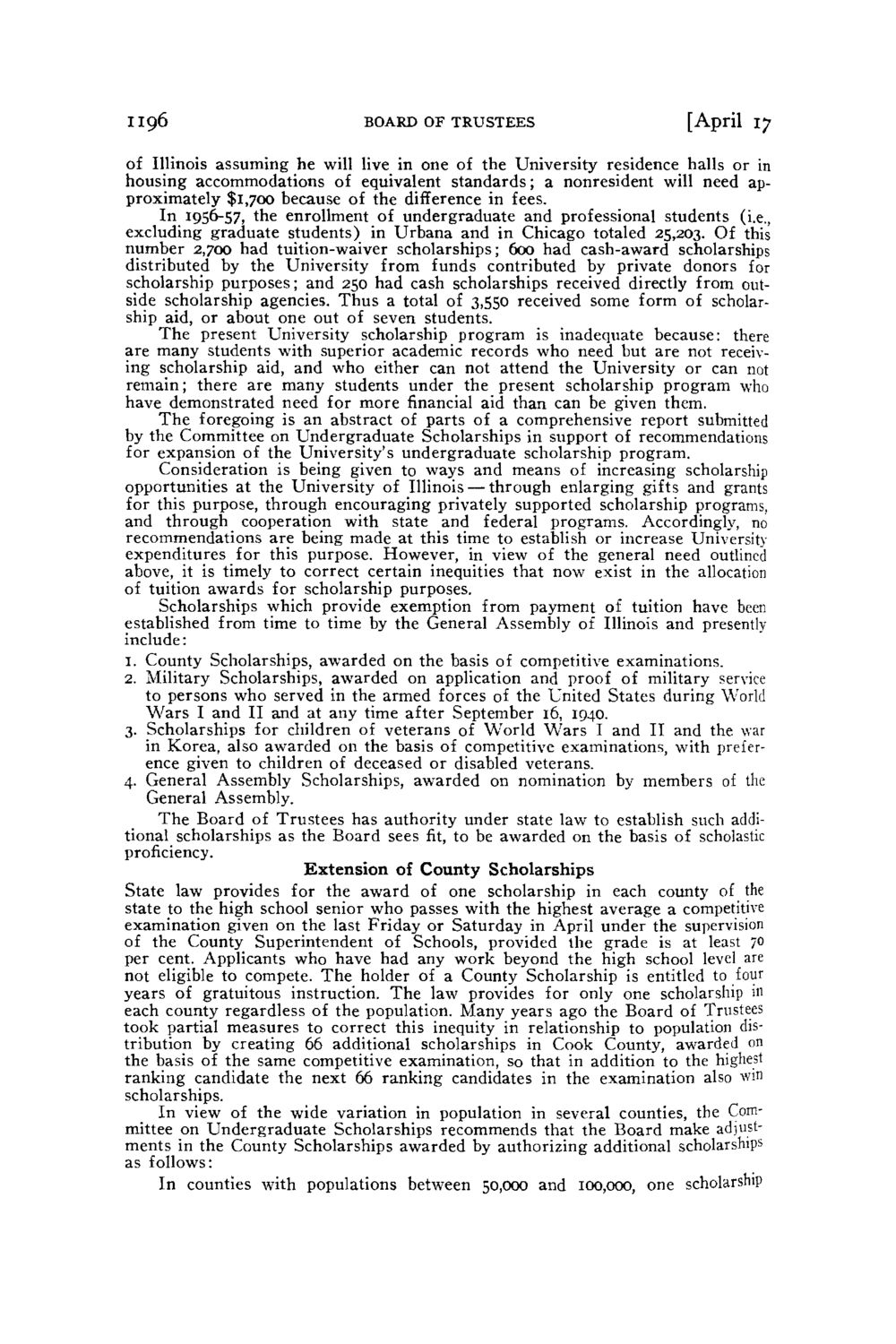| |
| |
Caption: Board of Trustees Minutes - 1958
This is a reduced-resolution page image for fast online browsing.

EXTRACTED TEXT FROM PAGE:
1196 BOARD OF T R U S T E E S [April 17 of Illinois assuming he will live in one of the University residence halls or in housing accommodations of equivalent standards; a nonresident will need approximately $1,700 because of the difference in fees. In 1956-57, the enrollment of undergraduate and professional students (i.e., excluding graduate students) in Urbana and in Chicago totaled 25,203. Of this number 2,700 had tuition-waiver scholarships; 600 had cash-award scholarships distributed by the University from funds contributed by private donors for scholarship purposes; and 250 had cash scholarships received directly from outside scholarship agencies. T h u s a total of 3,550 received some form of scholarship aid, or about one out of seven students. T h e present University scholarship program is inadequate because: there are many students with superior academic records who need but are not receiving scholarship aid, and who either can not attend the University or can not remain; there are many students under the present scholarship program who have demonstrated need for more financial aid than can be given them. T h e foregoing is an abstract of parts of a comprehensive report submitted by the Committee on Undergraduate Scholarships in support of recommendations for expansion of the University's undergraduate scholarship program. Consideration is being given to ways and means of increasing scholarship opportunities at the University of Illinois — through enlarging gifts and grants for this purpose, through encouraging privately supported scholarship programs, and through cooperation with state and federal programs. Accordingly, no recommendations are being made at this time to establish or increase University expenditures for this purpose. However, in view of the general need outlined above, it is timely to correct certain inequities that now exist in the allocation of tuition awards for scholarship purposes. Scholarships which provide exemption from payment of tuition have been established from time to time by the General Assembly of Illinois and presently include: 1. County Scholarships, awarded on the basis of competitive examinations. 2. Military Scholarships, awarded on application and proof of military service to persons who served in the armed forces of the United States during World W a r s I and II and at any time after September 16, 1040. 3. Scholarships for children of veterans of World W a r s I and II and the war in Korea, also awarded on the basis of competitive examinations, with preference given to children of deceased or disabled veterans. 4. General Assembly Scholarships, awarded on nomination by members of the General Assembly. T h e Board of Trustees has authority under state law to establish such additional scholarships as the Board sees fit, to be awarded on the basis of scholastic proficiency. Extension of County Scholarships State law provides for the award of one scholarship in each county of the state to the high school senior who passes with the highest average a competitive examination given on the last Friday or Saturday in April under the supervision of the County Superintendent of Schools, provided the grade is at least 70 per cent. Applicants who have had any work beyond the high school level are not eligible to compete. T h e holder of a County Scholarship is entitled to four years of gratuitous instruction. T h e law provides for only one scholarship in each county regardless of the population. Many years ago the Board of Trustees took partial measures to correct this inequity in relationship to population distribution by creating 66 additional scholarships in Cook County, awarded on the basis of the same competitive examination, so that in addition to the highest ranking candidate the next 66 ranking candidates in the examination also win scholarships. In view of the wide variation in population in several counties, the Committee on Undergraduate Scholarships recommends that the Board make adjustments in the County Scholarships awarded by authorizing additional scholarships as follows: In counties with populations between 50,000 and 100,000, one scholarship
| |